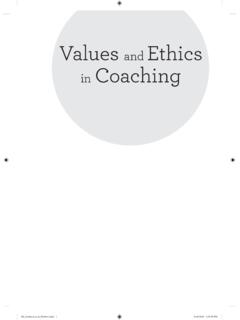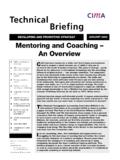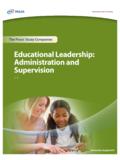Transcription of STAFF SUPERVISION IN THE EARLY YEARS FOUNDATION …
1 STAFF SUPERVISION IN. THE EARLY YEARS . FOUNDATION STAGE. Guidance for leaders on policy and practice for STAFF SUPERVISION meeting new statutory guidance Contents Introduction and context . p2. What is SUPERVISION ? p3-4. Key functions of SUPERVISION .. p4. Supportive working culture p4-5. Good practice in SUPERVISION . p5-6. What will Ofsted expect to be in place? ..p7. Models of SUPERVISION .p7-8. Model SUPERVISION Policy .p9-12. APPENDIX 1 STAFF SUPERVISION Agreement ..p12-13. APPENDIX 2 STAFF SUPERVISION Record Form ..p14. With kind permission, the following guidance draws primarily on the work of Karen John who recently produced guidance on policy and practice in STAFF SUPERVISION for the Pen Green Research, Development and Training Base and Leadership It further draws on the work of Professor Chris Pascal following her input earlier this year at an introductory seminar in Bristol for Children Centre Managers and Family Support Leads on the theme of 1 John, K.
2 & The Pen Green Team (2011). STAFF SUPERVISION in Children's Centres - Guidance on Policy and Practice. Corby, Northants: Pen Green Research, Training and Development Base and Leadership Centre 2 Chris Pascal (2012) Developing SUPERVISION in Children's Centres 1. Introduction The new EARLY YEARS ' FOUNDATION Stage places an increased emphasis on welfare and safeguarding standards, stipulating that regular STAFF SUPERVISION is now a statutory requirement. Clare Tickell's (June 2011) independent report of the review of the EYFS highlighted the role of SUPERVISION in improving practice and maintaining effective EARLY YEARS provision. Her recommendation for the implementation of sector-wide SUPERVISION , including childminders, underlined the need for support, performance management and continuous professional development, and this is specified within the revised EYFS.
3 As we strive to improve outcomes for all children and narrow the gap in achievement of vulnerable children in Bristol, safe' practices and the effective management of STAFF performance and well-being are of paramount importance. Comprehensive, inclusive policies and management systems for safeguarding practices must therefore include the regular SUPERVISION of all STAFF . Context As from September 2012, the new EARLY YEARS FOUNDATION Stage sets out a statutory requirement that all EARLY YEARS ' settings have arrangements for STAFF SUPERVISION in place. This highlights the importance of good supervisory practice throughout the EYFS in the context of a supportive professional culture to ensure the highest standards of safeguarding for both children and STAFF .
4 Providers must put appropriate arrangements in place for the SUPERVISION of STAFF who have contact with children and families. Effective SUPERVISION provides support, coaching and training for the practitioner and promotes the interests of children. SUPERVISION should foster a culture of mutual support, teamwork and continuous improvement which encourages the confidential discussion of sensitive issues.'. SUPERVISION should provide opportunities for STAFF to: . discuss any issues particularly concerning children's development or well-being;. identify solutions to address issues as they arise, and;. receive coaching to improve their personal effectiveness'. EYFS Safeguarding and Welfare Requirements 3:19 &3:20.
5 Professionally, STAFF SUPERVISION has been a normal part of counselling, psychotherapy and social work practice and is increasingly to be found in related caring professions, including medicine, nursing, education and children's services. At a time of heightened awareness of safeguarding issues, there is increasing recognition that working in the EARLY YEARS includes a high degree of outreach work and contact with families. Many practitioners find themselves working in unfamiliar 2. contexts and dealing with unpredictable issues. The need for keeping practice and practitioners safe' is a What is SUPERVISION ? Practitioners often manage increasingly complex issues in their intensive work with children and families.
6 They can feel anxious, discouraged or overwhelmed, lose confidence and perspective, feel threatened and unable to cope with the demands of their jobs. Even when things are going well, there is a need to step away from the day-to-day demands and review and reflect on practice. SUPERVISION provides a regular, dedicated time (approx. hours) for 1-1 or small group reflection and discussion. Commonly, SUPERVISION is organised over a 6-weekly cycle. The following definition recognises SUPERVISION as a core process by which those with leadership and management responsibilities regularly provide support and challenge to ensure and improve the quality of their services STAFF SUPERVISION is a two-way process which promotes accountability and STAFF support and development.
7 Both parties should be committed to making SUPERVISION worthwhile, positive, honest, objective and unbiased. The needs of the individual, the project or department where they work and the organization as a whole should all be taken into account. Parties should be fair and open and promote equality and trust. SUPERVISION should be a positive experience for all and take place regularly. If managers are not supervising their STAFF , they are omitting a key function of management.'. Developing SUPERVISION in Children's Centres, Chris Pascal (2012). 3 Chris Pascal (2012) Developing SUPERVISION in Children's Centres 3. SUPERVISION fulfills the following three main functions: Supportive/Restorative SUPERVISION is not counselling.
8 Rather this function focuses on how a STAFF member's work with children, families and other team members is affecting them personally. Key functions of SUPERVISION Management Developmental SUPERVISION is not the same as SUPERVISION is not training, but performance management, does concern the yet this supervisory function devlelopment of skills and concerns issues of quality understanding through assurance and safeguarding exploration and reflection, of the children and families which can help to identify who use services, ensuring training needs. that aims, principles, policies and standards are upheld. Supportive working cultures Critically, SUPERVISION should take place in the context of a supportive professional culture built on trust and respect, recognising the influence and impact of establishing good working relationships.
9 In relation to safeguarding, there needs to be recognition of the need to provide a 'safe' space to hold' the strong emotions that are sometimes aroused by issues that arise in efforts to protect children. This also applies to everyday, often personal issues presented by STAFF , impacting on their well-being and effectiveness. Such scenarios require emotionally intelligent leaders and managers who confidently offer opportunities for open, honest reflection and demonstrate commitment to supporting supervisees in finding ways forward. 4. It is, however, recognised that EARLY YEARS practitioners may feel uncomfortable with the term ' SUPERVISION ', which seems to imply being overseen, and this can evoke fear of being under surveillance, at risk of being judged or deemed inadequate in some way.
10 Whilst management is one of the three key functions of SUPERVISION , research suggests that good performance is more likely when a manager is respectful, assumes a collegial stance and comes alongside the STAFF member, inviting them to review their work and discuss any pressing issues - suggesting that together they might achieve a clearer and wider perspective (Hamlin & Sawyer, 2007), ultimately enabling 'super-VISION'.4. Of all the relationships we have at work, the one with our boss or supervisor has the greatest impact on our emotional and physical health.'. Goleman, 1998. Good practice in SUPERVISION Effective STAFF SUPERVISION is commonly characterised by the following features. Settings may wish to consider these as SUPERVISION standards and include them in a STAFF SUPERVISION agreement.









